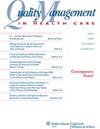Interprofessional Collaboration and Patient/Family Engagement on Rounds in a Comprehensive Stroke Center: A Mixed-Methods Study
IF 1.2
4区 医学
Q4 HEALTH CARE SCIENCES & SERVICES
引用次数: 0
Abstract
Daily rounds provide an opportunity for interprofessional collaboration and patient/family engagement, which are critical to stroke care. As part of a quality improvement program, we conducted a baseline assessment to examine interprofessional collaboration and patient/family engagement during the current rounding process in a 12-bed comprehensive stroke center. Findings from the baseline assessment will be used to inform the development, implementation, and evaluation of a new rounding model. The baseline assessment used a mixed-methods approach with a convergent parallel design. Although observations of the current rounding process were conducted to quantitatively assess interprofessional collaboration and patient/family engagement on rounds, qualitative interviews were conducted with different stakeholders to identify strengths and weaknesses of the current rounding process, as well as suggestions for facilitating interprofessional collaboration and patient/family engagement. We observed 103 table rounds and 99 bedside rounds and conducted 30 interviews with patients, families, and clinicians. Although the current process was perceived to facilitate interprofessional collaboration, the participation of nurses and other health care professionals on rounds was inconsistent due to competing clinical duties. Good practices for engaging patients and families during bedside rounds were also performed inconsistently. These findings lead to recommendations for revising the rounding process with poststroke patients, utilizing a more interprofessional collaborative approach with focus on patient/family engagement.综合卒中中心的跨专业协作和患者/家属参与查房:混合方法研究
每日查房为专业间协作和患者/家属参与提供了机会,这对卒中护理至关重要。作为质量改进计划的一部分,我们在一家拥有 12 张病床的综合性卒中中心进行了基线评估,以检查当前查房过程中的专业间协作和患者/家属参与情况。基线评估的结果将用于新查房模式的开发、实施和评估。 基线评估采用了混合方法,并采用了收敛平行设计。我们对现行查房流程进行了观察,以定量评估专业间协作和患者/家属参与查房的情况,同时还对不同的利益相关者进行了定性访谈,以确定现行查房流程的优缺点,以及促进专业间协作和患者/家属参与的建议。 我们观察了 103 次桌边查房和 99 次床边查房,并与患者、家属和临床医生进行了 30 次访谈。虽然目前的查房流程被认为有利于专业间合作,但由于临床职责的竞争,护士和其他医护人员参与查房的情况并不一致。在床边查房过程中让患者和家属参与的良好做法也不一致。 根据这些发现,我们建议对脑卒中后患者的查房流程进行修改,采用更多的跨专业合作方式,重点关注患者/家属的参与。
本文章由计算机程序翻译,如有差异,请以英文原文为准。
求助全文
约1分钟内获得全文
求助全文
来源期刊

Quality Management in Health Care
HEALTH CARE SCIENCES & SERVICES-
CiteScore
1.90
自引率
8.30%
发文量
108
期刊介绍:
Quality Management in Health Care (QMHC) is a peer-reviewed journal that provides a forum for our readers to explore the theoretical, technical, and strategic elements of health care quality management. The journal''s primary focus is on organizational structure and processes as these affect the quality of care and patient outcomes. In particular, it:
-Builds knowledge about the application of statistical tools, control charts, benchmarking, and other devices used in the ongoing monitoring and evaluation of care and of patient outcomes;
-Encourages research in and evaluation of the results of various organizational strategies designed to bring about quantifiable improvements in patient outcomes;
-Fosters the application of quality management science to patient care processes and clinical decision-making;
-Fosters cooperation and communication among health care providers, payers and regulators in their efforts to improve the quality of patient outcomes;
-Explores links among the various clinical, technical, administrative, and managerial disciplines involved in patient care, as well as the role and responsibilities of organizational governance in ongoing quality management.
 求助内容:
求助内容: 应助结果提醒方式:
应助结果提醒方式:


